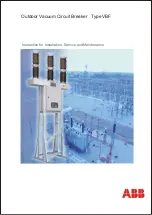
I N S T A L L A T I O N O F T H E S W I T C H G E A R A T S I T E
23
2.3.4 Installation of the busbar
2.3.4.1 General notes on busbar installation
The individual parts of the busbar adapters
(connections between the busbar sections of
each panel) are supplied packaged for all three
phases. Parts lists are enclosed with the material.
See section 8 for the part numbers of the
adapters and the required lengths of the busbars
for the adjacent panels.
End adapters are used at the ends of the
switchgear system and on Bus Tie panel, Bus
Riser panel and BusTie &Riser panel. Cross
adapters are to be installed in the busbar run.
The packaging for the busbar adapters contains
assembly paste. Use only this assembly paste to
grease the busbar components.
If it is intended to fit current transformers or
sensors in the busbar run, please note that the
current transformers or sensors are to be
installed during fitting of the busbars (see
section 2.3.3.6).
Storage of the busbars
When the busbars are removed from the
packaging, do not lay them on their
silicone surfaces. As the copper is very
heavy, the silicone can be damaged even
if the components are incorrectly stored
for a short period only. Always use the
spacers supplied for storage.
Checking the silicone surfaces of the components
Only remove the relevant component
from its protective packaging
immediately before assembly.
Check the silicone insulating part for
damage prior to installation.
If you note any damage on the silicone
insulating part, only use the component
after this has been agreed with ABB
Service Department.
The silicone surface must be free of
•
Gas bubbles.
•
Scoring.
•
Damage.
•
Abrasions.
•
Foreign bodies.
Cleaning soiled silicone surfaces
Components removed from the packaging can as
a rule be installed directly without cleaning. If
cleaning should nevertheless be necessary, clean
the components immediately before installation
as follows:
•
Remove surplus or dirty grease from the silicone
part with a soft, clean, non-fraying cloth.
Only use intensive cleaner M.X.T. 60 forte
as the cleaning agent.
•
Clean the silicone insulating part when required
with intensive cleaner M.X.T. 60 forte and a soft,
non-fraying cloth.
•
Only moisten the cloth slightly with intensive
cleaner. Apply only moderate pressure when
cleaning the insulating parts of busbar connections.
Do not wipe from the black areas towards the
light insulating surfaces. By adopting this
procedure, you avoid transferring black,
conductive material onto the light, insulating area.
•
After cleaning with intensive cleaner M.X.T. 60
forte, wipe the silicone insulating part with a
dry cloth.
As the cleaner causes the silicone to swell
slightly, it then has to dry for approx. 15
minutes in the air.
Checking the copper ends of the busbars
•
Inspect the copper ends for oxidation and
discoloration.
Cleaning the copper ends of the busbars
•
In the case of oxidation or the presence of
discoloration, clean the copper ends
immediately before installation with a clean
non-woven cloth. Inspect and clean the silicone
surfaces of the busbars as described above.
Checking the cast resin bushings
•
Inspect the cast resin bushings for damage. If
damage to a cast resin bushing is found, please
contact ABB Service Department.
Cleaning the cast resin bushings
•
Remove surplus or dirty grease from the silicone
part with a soft, clean, non-fraying cloth.
Only use intensive cleaner M.X.T. 60 forte
as the cleaning agent.
•
Clean the cast resin bushing with the cleaning
agent and a soft, clean, non-fraying cloth. Only
lightly moisten the cloth with intensive cleaner.
•
After cleaning with intensive cleaner M.X.T. 60
forte, wipe the silicone insulating part with a
dry cloth.
2.3.4.2 Assembling the busbar
The stud bolts (8) have been fitted as described in
section 2.3.1.3. The insertion depth of the stud
bolts and the centre to centre distances have been
checked in accordance with table 2.3.2.1.
Note on installation of the insulating plugs:
if the pick-off for capacitive indication of
the busbar voltage is to be installed on
the panel concerned, use insulating plugs
marked “MP” (see section 2.3.4.4). These
insulating plugs contain the capacitive
pick-off.
Assemble the busbars considering the assembly
instruction delivered by the manufacturer. The
assembly instruction is part of the busbar delivery.
2.3.4.3 Earthing the busbar
The busbar adapters are to be earthed at the
earthing lugs and additionally by means of
earthing clamps. Depending on the position and
design of the bars, the corresponding clamps as
shown in Fig.2.3.4.3.1 are to be used. The earthing
sets listed in table 2.3.4.3.1 contain the earthing
material (clamps, earthing leads and
materials for fastening to the clamps) for three
phases. The adapters are supplied with earthing
leads pre-assembled to the earthing lugs. The
material for fastening the earthing leads to the
enclosure is provided separately.














































